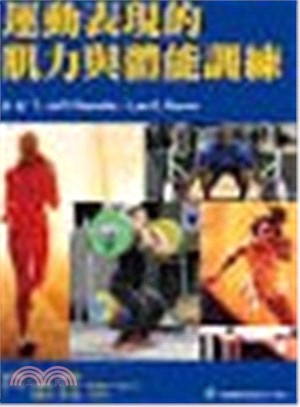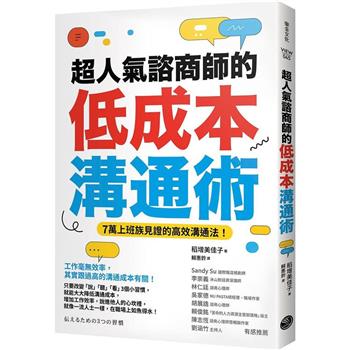| FindBook |
|
有 1 項符合
黃士魁的圖書 |
 |
$ 760 ~ 800 | 運動表現的肌力與體能訓練
作者:T. Jeff Chandler / 譯者:吳慧君、何立安、林文郎、相子元、姜義村、黃士魁、江界山 出版社:易利圖書 出版日期:2015-04-01 規格:30*21cm / 平裝 / 472頁  共 2 筆 → 查價格、看圖書介紹 共 2 筆 → 查價格、看圖書介紹
|
|
|
- 圖書簡介
總校閱序
近年來,由於神經肌肉生理學的研究探討,使得肌力及體能訓練知識的發展迅速,在國際體育運動領域也備受重視,且已成為運動訓練、復健、體能重建 (reconditioning) 與健康促進等不可或缺的應用技術與方法。由於肌力及體能訓練綜和運用了各種學科,如人體解剖學、運動生理學、運動生物力學與運動心理學等,而形成了一個應用多領域知識的高度應用科學。肌力訓練主要在於訓練改進身體的移動能力,而不是在訓練某個肌群,肌力訓練會提高神經肌肉的適應,而造成肌力和無氧動力的提高,透過負荷強度與負荷量的控制,也有助於提升有氧能力與動作經濟性的提升。因此,從競技運動的觀點,力量是無可取代的,在現代高水準的競技運動中,要想以頂尖的技術彌補力量的不足幾乎是不可能的,即使運動員的技術再高明,如果力量很薄弱的話,也很難在高水準的競技中勝出,尤其是,講求速度與爆發力的項目,如果沒有強大的肌力為基礎,技術很難持續而穩定的發揮出來,換句話說,好的技術需要足夠的肌力來支撐,當運動員在比賽中身心俱疲時,還能維持動作的姿勢其實是因為有足夠的肌力。
肌力訓練對耐力項目也很重要,肌力訓練可提高作用肌離子交換的能力,提高呼吸肌功能,提升最大攝氧量,因而增進高強度或低強度耐力項目的表現。研究的結果顯示,肌力訓練可以改善動作的控制能力,較高的肌力水準在促進動作經濟性上也扮演了重要的角色;透過肌力訓練,高強度的無氧運動改進醣解效應,也有助於無氧閾值的提升。觀察世界級四百公尺以內的短跑運動員,發現決勝的關鍵不是有氧或無氧能力,而是力量。因此,如果我們能夠加速培養理論與實務兼備的肌力及體能訓練專業人員,運用科學化的肌力及體能訓練新知與方法,並系統化的強化我國運動員的身體素質,將可大幅提升我國運動競技水準。
本書共分四篇、計十八章,包括:第一篇基礎科學、第二篇組織與行政、第三篇運動處方、第四篇特殊主題。本書作者傑夫 錢德勒與李 布朗,鑒於肌力及體能訓練工作雖可幫助運動團隊提升績效,但也認為這項工作也充滿著無限的挑戰與風險,因此,為確保肌力及體能訓練工作的品質,特別提供了五個重要的範例,包括:附錄A-陳述任務、目標與目的範例─提供肌力與體能訓專業準則,如美國國家肌力及體能訓練協會證照委員會準則,以強化訓練的品質;附B-政策與程序範例,提供重量訓練室營運使用的規則;附錄C-肌力及體能訓練專業標準與準則範例,強調肌力及體能訓練專業人員應遵守持續進修與道德規範的要求,在工作崗位上取得並維持專業證照的最高理念;附錄D-肌力及體能訓練績效團隊發展範例,提供肌力及體能訓練績效團隊,如醫生、急救人員與運動傷害防護員如何共同合作的範例,以提升績效;附錄E-緊急照護與計畫範例,包括如何扮演好緊急團隊的四個重要角色,以及遵循醫療緊急運送程序規範,以維護受傷者最大的就醫與健康權益。
運動訓練有三個終極目標,即:確保訓練過程零傷害、降低運動比賽時受傷的風險,以及增進運動競技表現。肌力及體能訓練是一項動態適應的系統工程,透過科學化、系統化的施行可有效的改造運動員的身體素質,加速達成上述三個終極目標。可惜的是,目前,肌力及體能訓練仍未被國內競技運動訓練界普遍的認識與接受,有待大家的關注與推展。本書翻譯團隊投入可觀的精力與腦力,共同完成本書的翻譯工程,目的在於呈現本書闡述的理念與方法,提供肌力與體能訓練的愛好者之參酌。感謝易利圖書有限公司的鼓勵與協助,更感念翻譯團隊的努力與付出,本書譯本才能順利出版。由於聯合翻譯工作繁複,如有改進之處,敬請不吝指教 - 目次
PART 1 基礎科學
Chapter 1 生物能量學 3
吳慧君 譯
Chapter 2 心肺系統 19
吳慧君 譯
Chapter 3 神經肌肉系統:訓練適應的解剖生理基礎 37
何立安 譯
Chapter 4 骨骼系統 55
相子元 譯
Chapter 5 體能訓練生物力學 71
相子元 譯
Chapter 6 內分泌系統對運動訓練的反應與適應 87
吳慧君 譯
Chapter 7 營養 115
吳慧君 譯
PART 2 組織與行政
Chapter 8 測驗實施與解讀 135
何立安 譯
Chapter 9 熱身與柔軟度 155
何立安 譯
Chapter 10 阻力訓練運動及補助技巧 169
何立安 譯
Chapter 11 場館經營與設計 223
何立安 譯
PART 3 運動處方
Chapter 12 運動的肌力與體能 239
林文郎、黃士魁 譯
Chapter 13 阻力訓練處方 155
林文郎、黃士魁 譯
Chapter 14 增進有氧運動能力的表現 271
林文郎、黃士魁 譯
Chapter 15 增強式肌力、速度與敏捷性訓練處方 285
林文郎、黃士魁 譯
PART 4 特殊主題
Chapter 16 特殊族群肌力訓練的基礎 325
姜義村、何立安 譯
Chapter 17 傷害防護及復健的原則 347
姜義村、何立安 譯
Chapter 18 強化劑 Ergogenic Aids 373
姜義村、何立安 譯
Chapter 19 特殊器材訓練 387
姜義村、何立安 譯
附錄 江界山 譯
附錄 A 417
附錄 B 421
附錄 C 425
附錄 D 429
附錄 E 431
附錄 F 431
索引 435
延伸的目錄 (Expanded Contents)PART 1 基礎科學
Chapter 1 生物能量學 3
前言 Introduction 3
酶 Enzymes 4
化學能量的產生 The “Creation”of Chemical Energy 6
能量系統 Energy Systems 6
磷酸肌酸系統 The Phosphocreatine System 7
能量產生的調節 Regulation of Energy Production 9
醣酵解系統 The Glycolytic System 10
有氧系統 The Oxidative System 10
乳酸 Lactate 11
細胞中能量產生的分解代謝過程之摘要 Summary of Catabolic Processes in the Prodution of Cellular Energy 14
能量產生途徑的效率 Efficiency of the Energy-Producing Pathways 15
影響表現的限制因素 Elimiting Factors of Performance 16
耗氧量 Oxygen Consumption 16
代謝的特殊性 Metabolic Specificity 17
總結 Summary 18
Chapter 2 心肺系統 19
前言 Introduction 19
心血管系統 Cardiovascular System 20
心臟的形態學 Morphology of the Heart 20
心週期 Cardiac Cycle 20
心跳率與傳導 Heart Rate and Conduction 21
心輸出量 Cardiac Output 23
血管組織 Vasculature 23
血壓Blood Pressure 24
呼吸系統 Respiratory System 24
氣體分壓差 Pressure Differentials in Gases 24
氧與二氧化碳的運輸 Oxygen and Carbon Dioxide Transport 26
血液 Blood 26
心血管系統對於運動的立即反應 Cardiovascular Response to Acute Exercise 26
心輸出量 Cardiac Output 26
心跳率 Heart Rate 27
每跳輸出量(Stroke Volume 27
心血管循環轉變 Cardiac Drift 28
動靜脈含氧差 a-Vo2 Difference 28
心輸出量的分佈 Distribution of Cardiac Output 28
血壓 Blood Pressure 28
運動時的肺部呼吸 Pulmonary Ventilation During Exercise 29
心血管系統對訓練的適應 Cardiovascular Adaptations to Training 29
心輸出量及每跳輸出量 Cardiac Output and Stroke Volume 29
心跳率 Heart Rate 29
血壓 Blood Pressure 30
心臟型態學 Cardiac Morphology 30
呼吸系統對訓練的適應 Respiratory Adaptations to Training 31
呼吸當量及每分鐘換氣量 Ventilatory Equivalent and Minute Ventilation 31
血液量對訓練的適應 Blood Volume Adaptations to Training 32
影響心肺呼吸功能的環境因素 Environmental Factors Affecting Cardiorespiratory Function 33
在熱環境下運動的心肺呼吸反應 Cardiorespiratory Response to Exercise in the Heat 33
海拔高度對心肺呼吸反應的影響 Effect of Altitude on the Cardiorespiratory Response 34
總結 Summary 35
Chapter 3 神經肌肉系統:訓練適應的解剖生理基礎
前言 Introduction 37
神經元 The Neuron 38
反射與不隨意動作 Reflexes and Involuntary Movements 38
本體感覺與運動感覺 Proprioception and Kinesthesis 38
高等神經中心與隨意肌肉控制 Higher Nerve Centers and Voluntary Muscular Control 40
錐體系統 The Pyramidal System 40
錐體外系統 The Extrapyramidal System 41
小腦本體感覺系統 The Proprioceptive-Cerebellar System 41
骨骼肌的大部結構 Gross Structure of Skeletal Muscle 41
骨骼肌的顯微結構 Microscopic Structure of Skeletal Muscle 41
肌纖維的構造 Structure of the Muscle Fiber 42
肌纖維種類 Muscle Fiber Types 42
肌原纖維結構以及收縮機制 Structure of the Myofibril and the Contractile Mechanism 43
肌肉收縮的肌絲滑動理論 The Sliding-Filament Theory of Muscle Contraction 44
力量的控制 Gradation of Force 45
肌肉活動類型 Types of Muscle Actions 45
等長肌肉活動 Isometric Muscle Actions 45
動態固定外力 Dynamic Constant External Resistance Muscle Actions 45
等速肌肉活動 Isokinetic Muscle Actions 46
向心及離心肌肉活動 Concentric and Eccentric Muscle Actions 47
阻力訓練的神經肌肉適應 Neuromuscular Adaptations to Resistance Training 47
肌力適應 Muscular Strength Adaptations 48
肌纖維適應 Muscle Fiber Adaptations 48
神經系統適應 Nervous System Adaptations 49
代謝適應 Metabolic Adaptations 52
內分泌適應 Endocrine Adaptations 52
總結 Summary 52
Chapter 4 骨骼系統
前言 Introduction 55
骨骼系統的結構 Structure of the Skeletal System 56
骨骼組織 Bone Tissue 56
韌帶組織 Ligamentous Tissue 59
軟骨 Cartilage 59
關節 Articulations 59
骨骼系統的功能 Functions of the Skeletal System 60
結構與保護 Structure and Protection 60
動作 Movement 60
血球的製造 Blood Cell Production 61
骨骼系統的生長 Growth Of The Skeletal System 61
骨骺中最初的骨骼生長 Primary Bone Growth in the Epiphysis 61
骨骼系統因應作用力所產生的適應性改變 Adaptations of the Skeletal System to Loading 62
沃爾夫定律 Wolff`s Law 62
最小基本應變 Minimal Essential Strain 63
骨骼系統對運動訓練所產生的適應性改變 Training Adaptations to the Skeletal System 64
骨骼系統與健康 The Skeletal System and Health 65
骨頭密度與健康 Bone Density and Health 65
脊椎排列疾病 Spinal Alignment Maladies 65
女性運動員三症候群 Female Athletic Triad 66
提升骨骼密度的運動處方 Exercise Prescription to Promote Bone Density 67
負荷速度 Loading Speed 67
負荷的速度與頻率 Rate and Frequency of Loading 67
負荷的方向與反應 Direction of Loading and Response 67
運動的強度 Intensity of Exercise 68
訓練的頻率 Frequency of Training 68
振動 Vibration 68
總結 Summary 69
Chapter 5 體能訓練生物力學
前言 Introduction 71
肌力體能訓練之生物力學概念 Biomechanical Concepts for Strength and Conditioning 72
力—速度—功率之關聯性 Force-Velocity-Power Relationship 73
骨骼肌肉構成之機器 Musculoskeletal Machines 75
槓桿系統 Lever Systems 75
輪-軸系統 Wheel-Axle Systems 75
肌肉功能之生物力學 Biomechanics of Muscle Function 77
長度-張力作用 Length-Tension Effect 77
肌肉的拉扯角度 Muscle Angle of Pull 77
力量曲線 Strength Curve 77
阻力的線與量 Line and Magnitude of Resistance 77
停滯區域 Sticking Region 78
肌肉構造,力量與功率 Muscle Architecture, Strength, and Power. 79
多關節肌,主動不足與被動不足 Multiarticulate Muscles, Active and Passive Insufficiency. 79
身體尺寸、體形、功率對體重的比例 Body Size and Shape and Power-To-Weight Ratio 80
平衡與穩定 Balance and Stability 80
穩定的因素 Factors Contributing to Stability 81
動作的開始或動作的改變 Initiating Movement or Change of Motion 81
伸展—縮短循環 Stretch-Shortening Cycle 81
阻力機器之生物力學 Biomechanics of Resistance Machines 82
自由重量 Free Weights 82
以重力為基礎的機器 Gravity-Based Machines 82
液壓阻力 Hydraulic Resistance 83
氣壓阻力 Pneumatic Resistance 84
彈性阻力 Elastic Resistance 84
機器訓練與自由重量訓練之比較 Machines Versus Free Weights 84
總結 Summary 85
Chapter 6 內分泌系統對運動訓練的反應與適應
前言 Introduction 87
內分泌系統 The Endocrine System 88
何謂荷爾蒙(激素) What Are Hormones? 88
內分泌組織 Endocrine Tissues 88
荷爾蒙的傳輸路線 Hormonal Transportation Routes 88
荷爾蒙的種類 Types of Hormones 90
荷爾蒙的生成 Hormone Production 91
荷爾蒙的運送與結合蛋白 Hormonal Transport and Binding Proteins 94
影響循環濃度的因子 Factors Affecting Circulating Concentrations 95
促激素與脈動 Trophic Hormones and Pulsatility 96
激素節律 Hormonal Rhythms 96
預期反應 Anticipatory Responses 97
生物區隔 Biocompartments 98
接受器與細胞訊號 Receptors and Cell Signaling 98
荷爾蒙水平的調控 Regulating Hormonal Levels 99
荷爾蒙對於運動的重要性 Hormones Vital to Exercise 100
睪固酮 Testosterone 100
皮質醇 Cortisol 100
睪固酮/皮質醇的比率 Testosterone/ Cortisol Ratio 100
生長激素 Growth Hormone 100
胰島素與昇糖素(胰高血糖激素) Insulin and Glucagons 101
腎上腺素 Epinephrine 101
正腎上腺素 Norepinephrine 101
醛固酮 Aldosterone 101
抗利尿激素 Antidiuretic Hormone 102
甲狀腺素 Thyroid Hormones 102
鈣調節激素 Calcium-Regulating Hormones 102
內分泌系統對於運動的效應 Effects of Exercise on the Endocrine System 102
急性與慢性的訓練適應 Acute and Chronic Training Adaptations 102
耐力運動對於荷爾蒙的反應與適應 Responses and Adaptations of Hormones to Endurance Exercise 103
阻力訓練的急性反應 Acute Responses to Resistance Exercise 109
阻力運動的長期適應 Long-Term Adaptations to Resistance Exercise 111
過度訓練與內分泌系統 Overtraining and the Endocrine System 112
利用內分泌系統來監控訓練 Using the Endocrine System to Monitor Training 112
理想的訓練課程設計 Optimizing the Training Program 113
目標:肌肥大 Goal:Muscle Hypertrophy 113
目標:不要肌肥大 Goal:No Muscle Hypertrophy 113
目標:高爆發力表現 Goal:High-Power Performance 113
目標:顛峰表現 Goal:Peak Performancec 114
目標:避免過度訓練 Goal:Avoiding Overtraining 114
總結 Summary 114
Chapter 7 營養
前言 Introduction 115
能量需求 Energy Needs 116
醣類的攝取 Carbohydrate Intake 118
蛋白質攝取 Protein Intake 119
脂肪攝取 Fat Intake 120
訓練期間的營養攝取 Training Nutrition 121
攝取營養的最適時間點 Nutrition Timing 122
醣類-蛋白質的比率 Carbohydrate-Protein Ratio 123
維生素與礦物質的攝取 Vitamin And Mineral Intake 123
維生素E Vitamin E 124
維生素C Vitamin C 124
礦物質 Minerals 125
飲食 Diets 126
極高醣與極低脂的飲食法(Very High Carbohydrate, Very Low Fat Diets 127
高醣低脂飲食法(High-Carbohydrate, Low-Fat Diets 129
低醣高蛋白質飲食法(Low-Carbohydrate, High-Protein Diets 130
低醣、高脂肪、高蛋白質(生酮)飲食法 (Low-Carbohydrate, High-Fat, High-Protein(Ketogenic) Diets 130
總結 Summary 131
PART 2 組織與行政
Chapter 8 測驗實施與解讀
前言 Introduction 135
測驗的目的 Purpose of Testing 136
測驗的選擇 Test Selection 136
效度 Validity 137
信度 Reliability 138
評估 Assessment 140
醫療病史以及PAR-Q Medical History and PAR-Q 140
醫師同意 Physician Release 140
營養 Nutrition 140
需求分析 Needs Analysis 141
解讀測驗 Test Interpretation 147
量度等級 Order Scales 147
數學測量 Mathematical Measures 149
分數的次數分配 Distribution of Scores 149
變異度 Variability 150
標準化分數 Standardized Scores 151
總結 Summary 151
Chapter 9 熱身與柔軟度
前言 Introduction 155
熱身運動 Warm-Up 156
柔軟度 Flexibility 156
正常的靜態柔軟度 Normal Static Flexibility 158
柔軟度與傷害的風險 Flexibility and injury risk 159
柔軟度的評估 Assessing Flexibility 160
柔軟度的發展 Development of Flexibility 161
生物力學對伸展的影響 Biomechanical Effects of stretching 163
伸展對於預防傷害的影響 Prophylactic Effects of stretching 164
總結 Summary 164
Chapter 10 阻力訓練運動及補助技巧
前言 Introduction 169
阻力訓練的益處 Benefits Of Resistance Traiining 170
安全性 Safety 171
保護 Spotting 171
運動時的穿著 Exercise Apparel 172
阻力訓練技巧 Resistance Training Technique 173
阻力訓練動作 Resistance-Training Exercises 174
總結 Summary 220
Chapter 11 場館經營與設計
前言 Introduction 223
場館和器材 Facilities and Equipment 224
設計與時程 Layout and Scheduling 224
場館維持及安全 Maintenance and Safery 225
法律義務及概念 Legal Duties and Concepts 226
標準的種類 Types of Standards 227
將實務運作標準應用於風險管理 Applying Standards of Practice to Risk Management 227
義務與責任:法律義務 Duties and Responsibilities:liability Exposure 228
參與訓練前的篩檢與排除 Preparticipation Screening and Clearance 229
人員資格審定 Personnel Qualifications 229
訓練計畫監督及指導 Program Supervision and Instruction 230
場館及器材設置、檢驗、保養、維修和標示 Facility and Equipment Setup, Inspection, Maintenance, Repair, and Signage 231
緊急事件的計畫與應變 Emergency Planning and Response 232
記錄及建檔 Records and Record Keeping 232
公平的使用機會和管道 Equal Opportunity and Access 232
兒童參與肌力及體能訓練 Participation in Strength and Conditioning Activities by Children 232
營養品、運動增補劑以及藥物 Supplements, Ergogenic Aids, and Drugs 233
政策與程序 Policies and Procedures 233
總結 Summary 234
PART 3 運動處方
Chapter 12 運動的肌力與體能
前言 Introduction 239
基本訓練原則 Basic Training Principles 240
訓練特殊性與訓練遷移效應 Specificity And Transfer-Of-Training Effect 242
爆發性肌力及爆發力 Explosive Strength and Power 242
訓練課程規劃 Program Planning 242
單組及多組 Single Sets versus Multiple Sets 242
週期性 Periodization 242
訓練進階運動員 Training Advanced Athletes 244
群組式小週期訓練 Summated Microcycles 249
總結 Summary 252
Chapter 13 阻力訓練處方
前言 Introduction 255
需求分析 Need Analysis 256
訓練課程變項 Acute Program Variables 256
訓練動作的選擇 Exercise Selection 256
訓練動作的順序 Exercise Order 257
訓練負荷 Loading 257
訓練量 Volume 258
休息間隔 Rest Interval 258
訓練頻率與訓練結構 Frequency and Workout Structure 258
肌肉收縮型態 Muscle Action 259
反覆速度 Repetition Velocity 259
阻力訓練處方 Resistance-Training Prescription 260
肌肉力量 Muscular Strength 260
肌肉爆發力 Muscular Power 261
肌肉肥大 Muscular Hypertrophy 264
局部肌耐力 Local Muscular Endurance 265
訓練進展 Progression 266
漸進超負荷 progressive overload 266
訓練多變性 Variation 266
訓練特殊性 Specificity 266
總結 Summary 267
Chapter 14 增進有氧運動能力的表現
前言 Introduction 271
影響有氧運動表現的因素 Factors That Influence Aerobic Exercise Performance 272
有氧訓練的方法 Approaches to Aerobic Training 273
持續訓練 Continuous Training 273
法特雷克訓練 Fartlek Training 274
間歇訓練 Interval Training 274
重覆訓練 Repetitions 276
組織有氧運動訓練 Organizing Aerobic Exercise Training 277
一般準備期 General Preparation Phase 280
特殊準備期 Special Preparation Phase 280
賽前期 Precompetition Phase 281
比賽期 Competition Phase 281
總結 Summary 282
Chapter 15 增強式肌力、速度與敏捷性訓練處方
前言 Introduction 285
肌肉伸展縮短循環 The Stretch Shortening Cycle 286
影響因素 Impacting Factors 287
增強式肌力訓練 Plyometrics 289
專有名詞 Terminology 289
發展順序 Developmental Sequence 289
訓練目的 Intended Purpose 290
訓練變項 Acute Training Variables 291
直線衝刺 Linear Sprinting 292
發展順序 Developmental Sequence 292
衝刺步伐 Sprinting Gait 292
訓練變項 Acute Training Variables 294
敏捷性 Agility 295
發展順序 Developmental Sequence 296
影響因素 Impacting Factors 297
動作速度的影響 Effects of Movement Velocity 297
角度的影響 Effects of Angles 297
預期心理的影響 Effects of Anticipantion 297
訓練變項 Acute Training Variables) 298
速度及敏捷性訓練活動 Speed and Agility Exercises 299
總結 Summary 320
PART 4 特殊主題
Chapter 16 特殊族群肌力訓練的基礎
前言 Introduction 325
老年人病學 Geriatrics 326
正常老化以及肌肉萎縮 Normal Aging and Sarcopenia 327
骨質疏鬆症 Osteoporsis 328
關節炎 Arthritis 329
兒科 Pediatrics 331
健康兒童以及青少年 Healthy Children and Adolescents 331
腦性麻痺 Cerebral Palsy 332
智能不足以及唐氏症 Mental Retardation and Down's Syndrome 333
肌肉萎縮症 Muscular Dystrophy 333
神經肌肉疾病 Neuromuscular Disease 334
中風 Stroke 334
纖維肌痛 Fibromyalgia 335
脊髓灰質炎後綜合症 Postpolio Syndrome 336
多發性硬化 Multiple Sclerosis 337
脊椎傷害 Spinal Cord Injury 337
後天性免疫不全症候群(AIDS)/人類免疫缺乏病毒(HIV) AIDS/HIV 339
慢性肺阻塞疾病 Chronic Obstructive Pulmonary Disease 339
心血管疾病 Cardiovascular Disease 340
肥胖症 Obesity 341
糖尿病 Diabetes Mellitus 342
癌症 Cancer 343
懷孕 Pregnancy 343
總結 Summary 344
Chapter 17 傷害防護及復健的原則
前言 Introduction 347
參與訓練前的身體檢查 Preparticipation Physicals 349
健康照護專業人員在傷害預防及復健計畫裡所扮演的角色 Roles of Health Care Professionals Involved in Injury Prevention and Rehabiltation 349
運動傷害分級 Injury Classification 350
組織復原的階段:臨床治療以及運動方面的顧忌 Phases of Tissue Healing: Clinical Treatment and Exercise Considerations 351
發炎階段 Inflammatory Phase 352
修復階段 Repair Phase 354
重塑階段 Remodeling Phase 356
重返活動階段:階段性訓練計畫的角色 Return-to-Activity Phase: The Role of the Interval Program 357
階段性重返活動訓練計畫 The Interval Sport-Return Program 357
熱身 Warm-Up 358
隔日訓練計畫 Alternate-Day Performance Scheduling 358
整合性體能訓練 Integration with Conditioning 358
強度的漸進階段 Progressive Stages of Intensity 358
適當的生物力學以及力學分析 Proper Biomechanics and Evaluation of Mechanics 358
收操或運動後的照護 Cool-Down or Aftercare 359
關節生物力學概論以及運動應用 Overview of Joint Biomechanics and Exercise Applications 359
膝關節生物力學概論與運動應用 Overview of Knee Biomechanics and Exercise Applications 359
肩關節生物力學概論以及運動應用 Overview of Shoulder Biomechanics and Exercise Applications 362
脊椎生物力學概論以及運動應用 Overview of Spine Biomechanics and Exercise Applications 364
總結 Summary 370
Chapter 18 強化劑 Ergogenic Aids
前言 Introduction 373
支鏈氨基酸 Branched-Chain Amino Acids 374
咖啡因 Caffeine 374
初乳 Colostrum 375
肌酸 Creatine 375
必須氨基酸 Essential Amino Acids 376
葡萄糖胺 Glucosamine 377
麩胺 Glutamine 377
甘油 Glycerol 378
綠茶萃取物 Green Tea Extract 379
Hmb 379
水分 Hydration 380
運動前後的營養補充 Pre-And Postworkout Nutrition 381
其他可能的強化劑 Other Potential Ergogenic Aids 382
總結 Summary 382
Chapter 19 特殊器材訓練
前言 Introduction 387
訓練計畫的相似性 Similarity in Training Programs 388
依靠科學 Relying on Science 388
缺乏特殊器材訓練的研究 Lack of Implement-Training Research 388
訓練原則 Training Principles 388
特殊器材對運動表現的可遷移性 Transderability of Implement Training to Sports Performance 389
充水器材 Water-Filled Implements 389
非傳統訓練器材可作為傳統訓練的輔助器材
Implement Training Should Supplement Traditional Methods 390
訓練計畫設計 Program Design 391
推薦之特殊訓練器材的說明 Description of Suggested Training Implements 393
小圓桶 Kegs 393
滾木 Logs 394
裝水啞鈴 Water-Filled Dumbbells 394
輪胎 Tires 394
壺鈴 Kettlebells 395
鐵鍊 Chains 395
沙包 Sandbags 396
特殊訓練器材說明以及訓練實例 Description of Implement Exercises and Examples of Workouts 396
總結 Summary 415
附錄
附錄 A 417
附錄 B 421
附錄 C 425
附錄 D 429
附錄 E 431
附錄 F 431
索引 435
|










